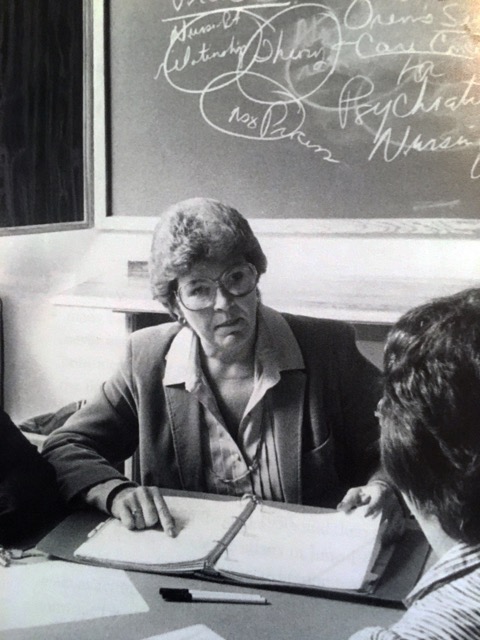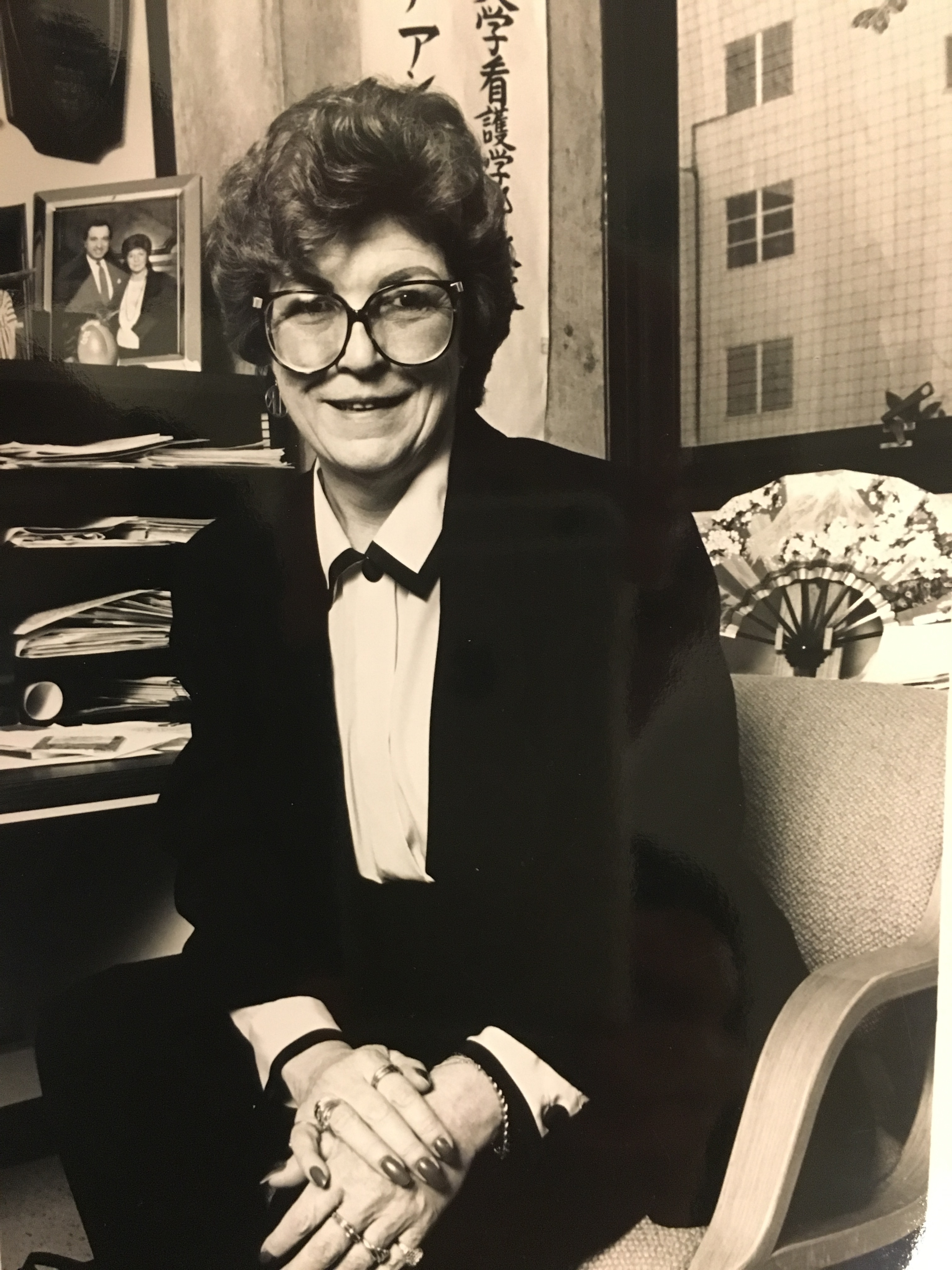
Patricia (Pat) Ruth Underwood, Professor of Clinical Nursing (Emerita) of the UC San Francisco (UCSF), died in Cape Coral, Florida on June 24, 2016 after a long illness. Pat received her BSN degree from the University of Colorado (1962), MA degree from New York University (1965), and her DNS degree from UCSF (1978). She ranked among the luminaries of professional nursing.
Background
Pat began her clinical nursing career in New York as a staff member, eventually progressing to Assistant Director of Nursing at Gracie Square Hospital. In San Francisco, she continued her clinical practice at UCSF’s Langley Porter Psychiatric Institute, advancing to Assistant Superintendent of Psychiatric Services and Clinical Nurse V, the highest clinical appointment. In 1968, she was appointed to the UCSF School of Nursing Psychiatric/Mental Health Nursing program, joining Marion Kalkman and Anne Davis, leaders in the field. This was during the transition from institutional care to community-based services for psychiatric/mental health patients, and to a new emphasis on patients’ rights. These changes had an important impact on the focus of clinical training in mental health. Pat’s first faculty activity at UCSF was to institute community-based clinical training sites for masters students in psychiatric/mental health nursing.
Contributions to Psychiatric/Mental Health Nursing
A master nurse clinician committed to the well-being of patients, Pat’s practice deeply informed her academic teaching. She recognized that through functional rehabilitation programs, nursing could play a fundamental role in assisting psychiatric/mental health patients to integrate more fully into their communities. She rapidly became a national leader in the development of theory-based, psychiatric/mental health nursing practice with her adaptation of Orem’s Self Care Model (SCM) as a curricular framework to educate Clinical Nurse Specialist students.
Pat’s work with the SCM enabled the program to participate in a multi-site, multi-disciplinary training grant in psychiatric rehabilitation. She then led efforts to implement the SCM in numerous community, Veterans’ Administration, and other treatment sites. A longtime dream of hers was realized in 1996 with the opening of the Mental Health Rehabilitation Facility at San Francisco General Hospital. It was established to provide long-term care and biopsychosocial rehabilitation services for residents with severe and persistent mental illnesses. The Underwood Model of Self Care Model of Nursing formed a critical component of patient care there, implemented by Alex Anagnos, one of Pat’s former Clinical Nurse Specialist students.
Leadership
In addition to her clinical and academic skills, Pat was a remarkable leader. She was appointed full clinical professor in 1983, and became Psychiatric/Mental Health Nursing Program Director, working alongside faculty members Betty Furuta, Holly Wilson, Linda Chafetz, Sandra Weiss, and Jane Norbeck. In 1988, she was appointed vice-chair of the Department of Mental Health, Community and Administrative Nursing (now known as Community Health Systems), serving first under Jane Norbeck and then Dorothy Oda. A strong advocate of shared faculty governance, Pat’s dynamism was a consistent reminder to nursing faculty about the importance of their participation in school, campus, and university policy development. She also played an early and influential role in developing and promoting the Master’s Entry into Professional Nursing (MEPN) program, which was established in 1984.
Pat was an active participant in professional nursing associations including the American Nurses’ Association, serving fifteen years as a convention delegate, and the former California Nurses’ Association (now ANA/C) for which she served as president from 1983-85. Under Mayor Art Agnos, she chaired the San Francisco Health Commission, the first nurse to hold this position. In 1991,she received the UCSF Chancellor’s Award for Public Service. Through her participation in professional and civic activities, Pat nurtured the political skills of a generation of students and professional colleagues. She served as a strong role model for students and colleagues, many of whom went on to leadership roles nationally and internationally—from Israel, Switzerland and Australia to Japan. In addition to generations of Clinical Nurse Specialists, for example, students became university faculty and deans, leaders at the World Health Organization and the International Council of Nurses, entrepreneurs, and consultants to organizations and companies. In recognition of her many contributions to professional nursing, she was elected to be a Fellow of the American Academy of Nursing.
Contributions to Nursing in Japan
Pat retired from UC in 1994 and moved to Japan, where she served as Professor at the College of Nursing Arts & Sciences, Hyogo, until her second retirement in 2001. At Hyogo, she helped Professor Hiroko Minami, Dean and also a former UCSF graduate, to establish Japan’s first university-based doctoral degree program in nursing. She was joined over the next few years by UCSF faculty Anne Davis, Betty Furuta, Pat Larsen, and more recently, Pamela Minarik. All were appointed to faculty positions as new nursing degree programs opened in universities. Pat, however, had been teaching and consulting in Japan since 1984. Over the course of her 20-year service to Japanese nursing, Pat contributed professionally in several ways. She introduced and strengthened the role of Clinical Nurse Specialists; consulted widely in hospitals and universities on psychiatric/mental health nursing, nursing administration and implementation of the SCM; served as an inaugural editor-in-chief of a new professional nursing journal; and developed a disaster nursing curriculum that has become a prototype for many university programs.
Care for the Care-Givers
The disaster curriculum emerged following the Great Hanshin/Kobe earthquake in 1995 that devastated infrastructure with thousands of lives lost. Pat, who lived nearby, recognized the immediate need for psychosocial trauma intervention to lessen the development of post-traumatic stress disorder (PTSD), especially in a nation where ‘silent suffering’ was the cultural norm. This was particularly cogent for those persons (health care, aid workers, volunteers and others) who provided assistance following overwhelming disaster. Her model of providing ‘care for the care-givers’ changed health care institutions across Japan and drew attention to the needs of those on the front lines of care and response. In 2002, she was recognized for her work in Japan with the Order of the Sacred Treasure – the Japanese Emperor’s highest award for service to the Japanese nation. Few women receive this award, and she was the second foreign woman ever to receive this high honor.
After Pat retired from Hyogo University, she and Maya Malarin, her partner and wife, lived in Kailua-Kona, Hawaii. For the last four years, they have been living in Cape Coral, Florida with their beloved dogs, Nikko and Luna.
